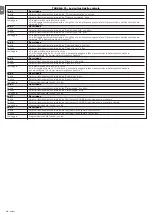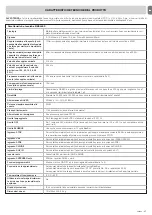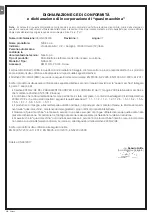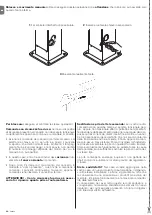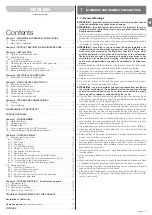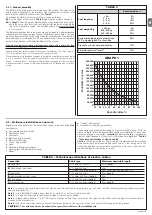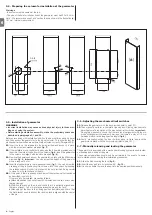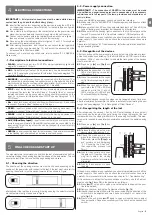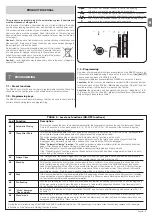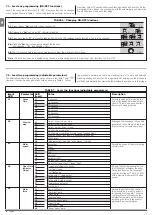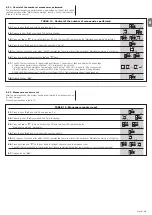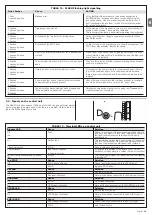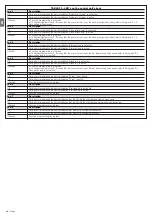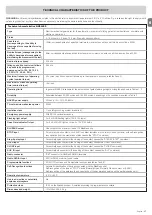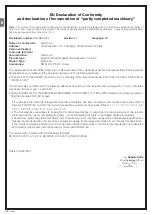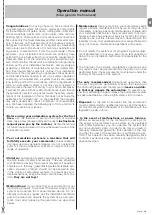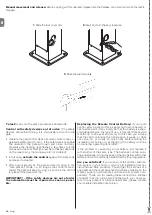
EN
10
– English
Level two:
The sequence to follow in order to change the factory settings of the parameters increasing the “
Pause Time
” to 60 seconds (input on L1
and level on L5) and reducing the “
Motor Force
” for light gates (input on L5 and level on L2) have been included as examples:
01.
Press the key
Set
and hold it down (approx. 3 s);
02.
Release the
Set
key when
L1
LED starts flashing;
03.
Press the key “
Set
” and hold it down during step 4 and 5;
04.
Wait approx. 3 seconds until LED L3, representing the current level of the “Pause Time” will light up;
05.
Press the
t
key twice to move the LED which is lit to LED
L5
, which represents the new “Pause Time” value;
06.
Release the key
Set
;
07.
Press the
t
key four times to move the flashing LED to LED
L5
;
08.
Press the key “
Set
” and hold it down during step 9 and 10;
09.
Wait approx. 3 seconds until LED
L5
, representing the current level of the “Motor Force” will light up;
10.
Press the
s
key three times to move the LED which is lit to LED
L2
, which represents the new “Motor Force” value;
11.
Release the key
Set
;
12.
Wait 10 seconds before leaving the programme to allow the maximum time to lapse.
FURTHER DETAILS
8
8.1 - Adding or removing devices
Devices can be added to or removed from the NAKED automation system at
any time. In particular, various devices types can be connected to “BlueBUS”
and “STOP” input as explained in the following paragraphs.
After you have added or removed any devices, the automation system
must go through the recognition process again according to the directions
contained in paragraph “8.1.6 Recognition of other devices”.
8.1
.1
- BlueBUS
BlueBUS technology allows you to connect compatible devices using only two
wires which carry both the power supply and the communication signals. All
the devices are connected in parallel on the 2 wires of the BlueBUS itself. It is
not necessary to observe any polarity; each device is individually recognized
because a univocal address is assigned to it during the installation. Photocells,
safety devices, control keys, signalling lights etc. can be connected to Blue-
BUS. The NAKED control unit recognizes all the connected devices individually
through a suitable recognition process, and can detect all the possible abnor-
malities with absolute precision. For this reason, each time a device connected
to BlueBUS is added or removed the control unit must go through the recogni-
tion process; see paragraph “8.1.6 Recognition of Other Devices”.
8.1
.2
- STOP input
STOP is the input that causes the immediate interruption of the manoeuvre
(with a short reverse run). Devices with output featuring normally open “NO”
contacts and devices with normally closed “NC” contacts, as well as devices
with 8,2KΩ, constant resistance output, like sensitive edges, can be connected
to this input.
During the recognition stage the control unit, like BlueBUS, recognizes the
type of device connected to the STOP input (see paragraph “8.1.6 Recognition
of Other Devices”); subsequently it commands a STOP whenever a change
occurs in the recognized status.
Multiple devices, even of different type, can be connected to the STOP input if
suitable arrangements are made.
• Any number of NO devices can be connected to each other in parallel.
• Any number of NC devices can be connected to each other in series.
• Two devices with 8,2KΩ constant resistance output can be connected in
parallel; if needed, multiple devices must be connected “in cascade” with a
single 8,2KΩ.
• It is possible to combine Normally Open and Normally Closed by making 2
contacts in parallel with the warning to place an 8,2KΩ resistance in series
with the Normally Closed contact (this also makes it possible to combine 3
devices: Normally Open, Normally Closed and 8,2KΩ).
IMPORTANT
– If the STOP input is used to connect devices with safety
functions, only the devices with 8,2K
Ω
constant resistance output gua-
rantee the fail-safe category 3 according to EN standard 954-1.
8.1
.3
- Photocells
By means of addressing using special jumpers, the “BlueBUS” system enables
the user to make the control unit recognise the photocells and assign them
with a correct detection function. The addressing operation must be done both
on TX and RX (setting the jumpers in the same way) making sure there are no
other couples of photocells with the same address.
In an automation mechanism for sliding gates with NAKED you may install pho-
tocells as shown in table 9 and fig. A.
Each time a photocell is added or removed the control unit must go through
the recognition process; see paragraph “8.1.6 Recognition of Other Devices”.
TABLE 9
-
PHOTOCELL ADDRESSES
Photocell Jumper
FOTO
External photocell h = 50
activated when gate closes
FOTO II
External photocell h = 100
activated when gate closes
FOTO 1
Internal photocell h = 50
activated when gate closes
FOTO 1 II
Internal photocell h = 100
activated when gate closes
FOTO 2
External photocell activated when gate opens
FOTO 2 II
Internal photocell activated when gate opens
FOTO 3
Single photocell for the
entire automation system
IMPORTANT
– in the case of the installation of FOTO 3 and FOTO II
together the position of the photocell elements (TX-RX) must comply
with the provisions contained in the photocell instruction manual.
10 s
3 s
L5
Stop/Se
t
L1
Stop/Se
t
3 s
L3 3 s
Clos
e
L5
4x
3x
Ope
n
L2
Stop/Se
t
Stop/Se
t
L5
2x
Clos
e
Stop/Se
t
Stop/Se
t
Summary of Contents for Naked Sliding NKSL400
Page 2: ......
Page 43: ...I 405 mm 131 mm 135 mm 1 3 4 5 b d c c h l b f m g i n e a E C F D C F A B 2...
Page 44: ...II b a b a c 5 mm 6 7 10 11 8 9...
Page 46: ...IV 14 15...
Page 48: ...VI 19 20 a b c d e...
Page 49: ...VII 21 22...
Page 50: ......
Page 51: ......

